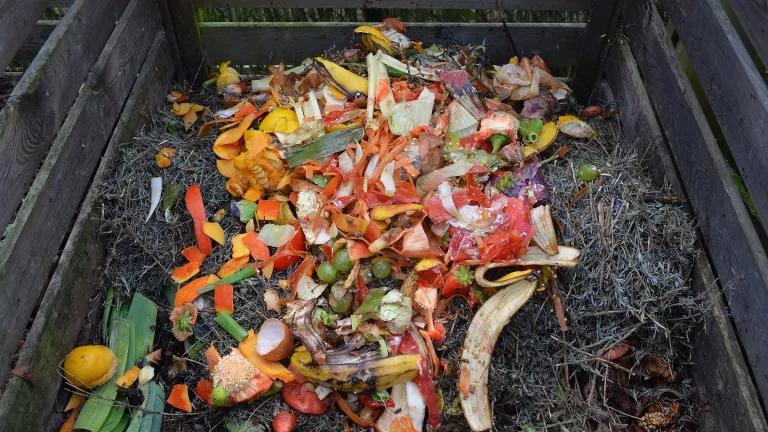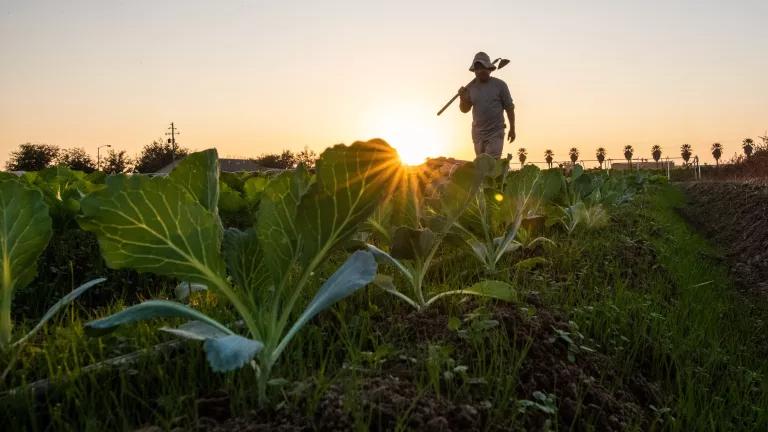Visionary Investments Could Advance Climate & Equity in Ag
Congress is preparing to consider a historic $135 billion investment in agriculture to fight climate change and deliver resources to farmers and families in need of support, and we need this bold investment now.

Patrick Bittner (left), a farmer in Evansville, Indiana, and Keith Williams, Indiana NRCS planning team leader, examine how a diverse 12-seed mix of cover crops impacted soil health.
Congress is preparing to consider a historic $135 billion investment in agriculture to fight climate change and deliver resources to farmers and families in need of support. The package would be the largest investment in conservation since the Dust Bowl, and it would support a variety of climate-friendly programs that empower a new cadre of farmers to regenerate the land and prepare our agricultural system to weather the impacts of climate change. It would also direct significant funding to historically underrepresented farmers and to children facing food insecurity.
Transforming Agriculture from Climate Liability to Climate Solution
Fighting climate change requires a forward-looking and equitable approach to agriculture. Ten percent of U.S. greenhouse gas emissions come from agriculture, and these emissions have been growing. In particular, agriculture is the second largest domestic source of methane (one of the most potent greenhouse gases), and industrial animal agriculture is responsible for an outsized portion of that footprint. But agriculture also offers unique opportunities to advance climate solutions. Cultivating healthy soil with regenerative and organic practices—including cover cropping, crop rotation, composting, polycultures, and farming without synthetic pesticides and fertilizers—can draw down carbon from the atmosphere while also increasing the capacity of farms to survive droughts, floods, and other extreme weather.
Proposed Investments Recognize the Need for Transformation
The good news is that leaders in Congress, including agriculture committee chairs Senator Stabenow and Congressman Scott, recognize agriculture’s potential climate benefits and are willing to partner with the Biden Administration in the Build Back Better agenda. The proposed $135 billion food and agriculture package includes $28 billion of climate-focused investments in longstanding, high-demand conservation programs that will help farmers and ranchers both prepare for and slow climate change—while also protecting human and environmental health—by expanding use of regenerative and organic practices on agricultural lands. Highlights include:
- Over $20 billion total for the Conservation Security Program (CSP), Regional Conservation Partnerships Program (RCPP), and Environmental Quality Incentives Program (EQIP), to help farms adopt climate-friendly farming practices. Importantly, the package waives the existing requirement that half of EQIP funds go to livestock operations—a sign that the agriculture committees are willing to carefully scrutinize industrial animal agriculture’s role in climate change.
- $5 billion for a cover crop and soil conservation assistance program that will promote regenerative practices and improve farms’ resilience to extreme weather, build soil organic matter, reduce erosion, and keep the land productive.
- $600 million to assess the climate benefits of healthy soil, including quantifying and validating field practices for soil and carbon management.
- $1.5 billion for the Agricultural Conservation Easement Program to protect agricultural land as well as natural resources.
- $250 million for conservation technical assistance and regional climate hubs to help farmers implement best practices.
In addition to conservation funding, the full proposed food and agriculture package supports important shifts toward healthy, sustainable, and equitable food systems. It would direct $7.75 billion to climate-focused agricultural research and infrastructure, including the Sustainable Agriculture Research and Education (SARE) program and the Organic Research and Education Initiative, two key sources of innovation and information for organic and regenerative producers. The package would also provide significant resources for farmers who haven’t received a fair share of federal support, including financial support, technical assistance, land loss assistance, and research, as well as funding for commissions to address racial equity at the U.S. Department of Agriculture. Finally, the package would dedicate nearly $35 billion to child nutrition to ensure that more children have access to healthy meals.
The food and agriculture reconciliation package represents a bridge for climate-friendly agriculture that will prepare our food system for the difficult challenges ahead and improve support for farmers and communities who have been harmed by U.S. food and farm policy for centuries. Now is the time for bold investments to propel the Build Back Better agenda.




